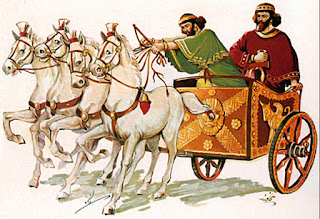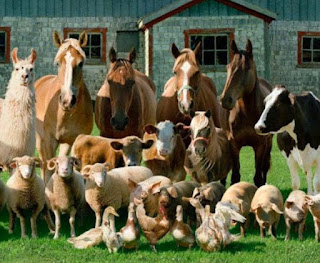As an example, one theorists has written: “Horses are mentioned in the Book of Mormon is unstated. How they were used, when, and by whom, is left unsaid. Indeed, needing to say that they were useful on some occasions seems to imply something remarkable or unusual, otherwise the point would not need to be mentioned.”
As Mormon writes: “Now the king had commanded his
servants, previous to the time of the watering of their flocks, that they
should prepare his horses and chariots, and conduct him forth to the land of
Nephi; for there had been a great feast appointed at the land of Nephi, by the
father of Lamoni, who was king over all the land—what exactly is unusual about
this use of horses and chariots?
This theorist gives us three reasons regarding their being mentioned. Only the first one makes any sense at all:
1. There were actual horses. Perhaps the most straightforward approach is to assume that horses, which subsequently became extinct, were available in the area in which the Nephites and Lamanites lived. It is not unusual for primary source documents to mention things, which archaeologists cannot prove. In fact, it is expected that authentic documents will give us new information about the past.
Did Nephi, who was a farmer and
worked on his father’s farm, mistook a tapir for a horse, as Sorenson claims? You think?
3. “Horse” Could be a Result of Translation. It is also possible that “horse” is a “translator anachronism.” Brant A. Gardner explains, “We need look no further than the King James translation of the Bible for examples of anachronisms that occur only in translation and not in the text being translated.” One prominent example is the mention of candles, which were not invented in biblical times, though the term is used in reference to oil lamps. “Thus, the word candle is an anachronism, but only in the translation.” Without the original text, it is impossible to be sure whether “horse” is a loan-shift the Nephites made or an anachronism caused by translation, but in either case the word “horse” would not refer to what today’s readers might assume or expect. One should be aware of these possibilities while reading references to horses and other plants and animals not commonly thought to be in the Americas during Book of Mormon times.
Does anyone really believe that
Nephi, who worked around animals most of his life, or Joseph Smith, who knew
all about horses and farm animals, would have mistakingly considered a tapir a
horse?
Consequently, it adds nothing to the effort of understanding Mormon’s words to consider that they might be wrong because of translation error, or that Nephi borrowed the word for “horse.”
The theorist goes on to write: “In fact, in many cultures and on various topographies, horses are not useful, being hard to tame and costly to maintain.”
Actually, horses are one of the easiest animals, either wild or feral, to break to human use—usually one good ride will do it—and the animal is quite docile, easily ridden or used to haul or pull thereafter. However, the theorist is not finished. He adds, “While there is no definitive answer to why horses are mentioned in the Book of Mormon, each of these prospects creates room for further exploration, wondering, understanding, and especially faith. Each possible explanation also teaches important lessons about archaeology, ancient writings, and the nature of translations that need to be taken into account when considering information, insights, questions, and curiosities about the Book of Mormon.”
Common animals are pretty well understood by most ancient people since
they worked with them nearly every day. A new animal, such as the cumom and
curelom, were unknown and in the Book of Mormon, were not given inaccurate
names in a translator anachronism
He also wrote: “Readers can interpret the presence of horses in the Book of Mormon in a variety of different ways.”
The problem with this kind of theorist is the constant attack on the plain and simple language of the Book of Mormon—the language that Nephi loved and used and commanded those who wrote after him to use. A language that is clear and understandable. In this case, a horse is a horse, and would have been used by the Nephites as most cultures and civilizations have used throughout history. Why would anyone think any different on this matter. The only caveat would be to recognize that the Lord’s people never used horses in the promotion and promulgation of war. But they were certainly used for transportation and as beasts of burden—exactly what we see in the scriptural record.
It should always be kept in mind that Book of Mormon subjects once considered anachronistic have since been verified, which has led John E. Clark, a Latter-day Saint and prominent Mesoamerican archaeologist, to declare: “the Book of Mormon looks better with age” (Clark, “Archaeological Trends,” p94)
Such findings should urge caution against making final judgments based on absence of evidence.
Another comment from this theorist: “Throughout history, when immigrants and travelers have encountered new and unfamiliar species, they have often applied labels from their own language, which originally referred to different animals. In many cases, the borrowed term has become the common name.”
However, this is not true when it comes to the Book of Mormon, which any cursory view would show. As an example, when Joseph Smith encountered the two animals, cumom and curelom, that were unknown to him in New England area 1829, he simply used the name given in the record; and the same is true with the two grains, neas and sheum, and the metal ziff. To even suggest that he might have used a substitute name is incomprehensible given the facts of his translation.
So when is a horse not a horse? It appears not to be a horse when it conflicts with the mainstream Land of Promise theorists because it is uncomfortable for them to support such a controversial issue used by critics to thwart the importance and accuracy of the written word.









No comments:
Post a Comment